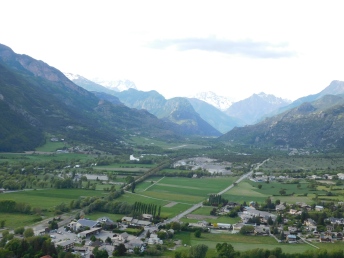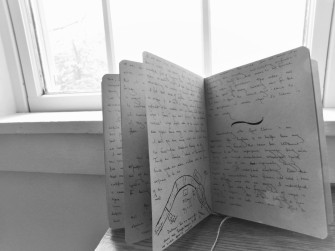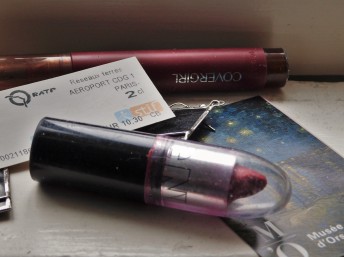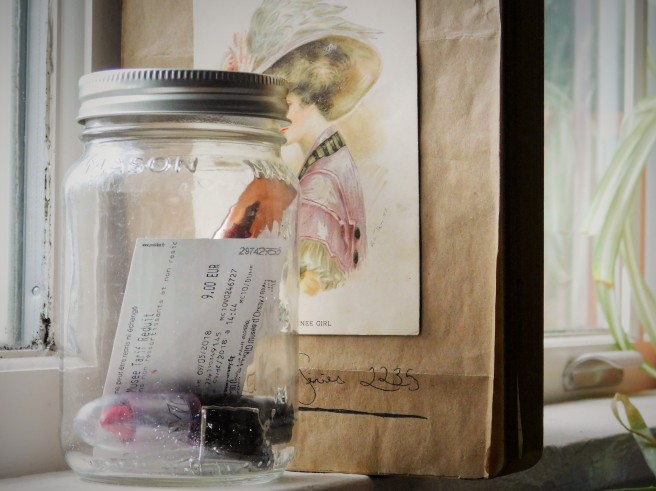I believe in greetings.
“Goodbye,” “Hello,” “I miss you,” “How was your day?” – These are the coffee of relationships, what we drink every morning to sustain us through the day. They hold great power in their mundane consistency. They are invitations to know a person better, to live among each other, to share in joys and sorrows together. Sometimes we don’t take them that way. “Good,” we say, and move on. But sometimes we say “I miss you too. Yesterday I saw a poem that made me think of you…” and a tiny fragment of a shared story is glued in place.
When I think of France, I think of these moments of greeting and farewell. They were more potent than in normal life: sometimes because I was meeting a person or a place for the first time, sometimes because I was returning after more than two years of absence, and sometimes because they were the only portions of a conversation I understood.
Yet there was something about them – these unhurried moments of making and confirming relationships – that knit my time in France together. And so as I share my memories of that time with you, dear reader (which will happen in several parts here and there), I share them in the spirit of greeting – moments where my story got glued into that of another time and place.
“Welcome”
Getting to the Alps is one of the scarier experiences of my life.
I take a train from Paris into Italy, straining to hear the announcements (which are in French) and craning my neck to see signposts as the train slows and gathers speed. My stop is a tiny town just over the border, where a Great Uncle I’ve never met will pick me up from the station and drive me back into France. If I miss the platform, I’ll end up in Rome, alone in the dusk, without a return ticket. If I miss my Great Uncle, I’ll end up in a tiny Italian village, alone in the dusk, without a return ticket. I don’t speak French. My Great Uncle doesn’t speak English. Neither of us speak Italian. What could go wrong?
But as the train winds its way through flat farmlands into hills, and then through tunnels that emerge into Alps, I forget to be nervous. I give up on reading, or worrying, or doing anything productive in lieu of staring. There’s a fondness with which my grandmother speaks of her homeland. She says “my mountains” as if, by product of being born in their shadow, they belong to her. I wasn’t born in their shadow; I cannot claim these giants as my own. I can only stare as they go speeding past, shrouded in fog and snow.
 My Great Uncle turns out to be easily identifiable, and with my traveler’s backpack and the boots hanging off one side, I am too.
My Great Uncle turns out to be easily identifiable, and with my traveler’s backpack and the boots hanging off one side, I am too.
On the car ride back into France, he is content to smile at my dazed expression as I take in the world that is his home.
“Like?” he asks in accented English.
Sometimes it is the scariest things that are the most worthwhile.
“It’s so Strange to Finally Meet You in Person”
Two months ago, I was standing in the Victoria and Albert Museum (fondly known as the V&A), looking at the floor plan for Versailles. How it ended up in England is a mystery, but my friend and I spent nearly a half hour slowly leafing through, marveling at how big, how opulent such a place must be, to merit an entire book of detailed drawings. There were palaces and summer houses, statues, gardens, and stables. And fountains. So many fountains I wondered if there was a dam somewhere to feed them all. Did they even have dams in the eighteenth century?
 They must. The thought arrives in a flash of memory as I watch water rise a hundred feet in the air to drop at my feet in a perfect arc. This is the central fountain of Versailles – it took us an hour of walking to reach it. Around the bridge we’re standing on is a lake (where a hundred rowboats mosey around, looking insignificant in the vast surface), and in front of that lake, through the shimmer of the fountain: The Palace of Versailles. It’s the size of a city block.
They must. The thought arrives in a flash of memory as I watch water rise a hundred feet in the air to drop at my feet in a perfect arc. This is the central fountain of Versailles – it took us an hour of walking to reach it. Around the bridge we’re standing on is a lake (where a hundred rowboats mosey around, looking insignificant in the vast surface), and in front of that lake, through the shimmer of the fountain: The Palace of Versailles. It’s the size of a city block.
The first thought that comes after I table the dam debate is something along the lines of: what is my life? Two months ago I was flipping through two-hundred year old architectural drawings, today I’m standing in the middle of the finished product. Two months ago I was in London, in a museum named after a Queen, today I’m standing in a King’s legacy.
The second is: I have never seen this much gold in one place.
It’s everywhere – on fences, adorning statues, inlaying the curves of the palace gutters. Versailles is known for the Hall of Mirrors, but I don’t need to enter that room to see my reflection. Each new step leads to another shiny surface that sends my own distorted image back.
In some ways, it reminds me of a cathedral. It’s lavish, made as a statement, and made off the back’s of people’s suffering and poverty. But unlike a cathedral, there’s no area of grey, no sense that this world treasure had been built for the glory of God or that the people who built it believed in anything but not getting their heads chopped off. It’s a testament to both the human capacity to make beauty and the human capacity for greed.
So I marvel. At the size of the building, at how many different people are represented by the hundreds of statues, at the fact that I saw little x’s representing those statues in another country, in another world. And I marvel that one place can make me feel such awe and sadness. That both are correct responses to this place, that one cannot exist without the other.
“I’ll Be Back”
When my Great Grandfather died, one of his sons built a cross and placed it on the top of an Alp. There’s a picture in my grandmother’s house of this cross, and of some of my relatives standing next to it, disarrayed and triumphant in eighties wind-breakers. When my grandmother said “Anna, you must go to the Alps,” I said back, “To climb to your father’s cross.”
 Throughout my trip, people have treated this claim with varying degrees of skepticism. Some of it I get; most people don’t look at me and think, “now that girl, she probably climbs Alps in her spare time.” But some of the raised eyebrows seem unwarranted. I understand that Alp means steep. I understand they require decent footwear (I may have hiked my first one in combat boots. All 8,500 feet of it). I understand that once I start I can’t come back down.
Throughout my trip, people have treated this claim with varying degrees of skepticism. Some of it I get; most people don’t look at me and think, “now that girl, she probably climbs Alps in her spare time.” But some of the raised eyebrows seem unwarranted. I understand that Alp means steep. I understand they require decent footwear (I may have hiked my first one in combat boots. All 8,500 feet of it). I understand that once I start I can’t come back down.
Now, though, now I get it. Those raised eyebrows were not about me. Or at least about my fitness and footwear. They were about my delusion that I could climb an Alp that’s also covered in snow. May is not a good hiking month for mountains; the altitude means that it can snow on the summits and rain in the valleys at the same time. Which it did, last night.
Instead I have to settle for a trip up to the base of the mountain and a pair of my Great Uncle’s hunting binoculars. Through their lenses, I can see the beams of the cross, surrounded on all sides by white. When I take the glasses off, I can still see it, now a speck of black on the top of a very big hill. Someday, I promise myself. Someday.
As if reading my thoughts, my Great Uncle says to me, “You come back other year. In summer?”
I answer him with the same word I use for ninety percent of my French communication.
“Oui”
“A Tuttalo”
I sometimes wonder how every city can have a different ambiance, a different sort of magic. In her book Eat Pray Love Elizabeth Gilbert writes that each city has a crucial word, a word that defines its essence. I wasn’t sure what to make of her theory, because much like a work of art, what people get out of a specific time and place varies. Our tastes – or as George Eliot wrote – our vanities, differ as our noses do.
But I think Gilbert still has a point, at least on an individual basis. My word might be different than yours, and indeed, I suspect it is. Some people call Paris the city of love. Some people claim it’s the artistic capital of the world. I call it…shabby chic.
It’s a quilting word, to describe fabrics. They’re patterned, usually floral and always muted. A shabby chic quilt is defined by its overall color palette, and the ability to put several designs next to each other because each one compliments the other.
As I stare out my Great Aunt’s window, I see so many different things. Street lamps, illuminating tiny European cars. The lights of the city, stretching into the distance. Buildings that don’t precisely match, but go together somehow. And across the rue, a man and woman sit on their balcony together, reading, glasses of wine and a candle keeping them company. Somewhere a trumpet wails – a few blocks away, perhaps. And then there’s me, the novice content to watch the night unfold through the gauzy white curtain that blocks my body but not my view.
This is my last night in Paris. By my bed sits a fully packed backpack, ready to once again weigh down my shoulders in the morning. I’ve checked my plane ticket twice, my phone is charging, and my passport sits on the bedside table where it can scream, “DO NOT FORGET ME, I AM IMPORTANT” at me tomorrow.
But for tonight, I am still here, still standing by the window wondering how all of these elements – the wailing trumpet and the tiny cars – can possibly go together. They do, somehow. And I am also wondering when I will see them again.
I don’t know. It’s not a sad statement but an adventurous one. Who knows what the future holds? Who knows what other cities will get strange Anna words between now and my return? It’s exhilarating to think about and for tonight I have this – this shabby chic ambiance of a city. I have, too, a phrase to say at it. Aunt Ivette taught it to me this week, with much head shaking over my pronunciation. Now, when I say it she recognizes it as French, which is an improvement. I assume, if it passes the Aunt Ivette standard, the city will probably accept it too.
So, then.
A tuttalo, the street lamps and tiny cars.
A tuttalo, the buildings that mesh but don’t match.
A tuttalo the man and woman sipping wine and laughing.
And A tuttalo the wailing trumpet.
Although I have no way to predict, I hope I’ll see you soon.

Collection of Kisses: Part 3 is the final installment in a series of posts about my travels in France. Part 1 and Part 2 can be found here.

